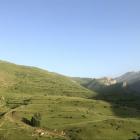Postconflict memoryscapes link past and present, history and future, remembrance and repair. They connect physical places of conflict with immaterial spaces of situated memory. Particularly in contexts of contested histories where, as Stefanie Kappler argues, memory functions “as a mediator of social relations,” memoryscapes create stories of past conflict that influence visions of future peace. In Kosovo, although periods of Albanian-Serb cooperation are part of the history, conflict parties have reactivated conflict narratives based on nationalist memoryscapes that are anchored in the territory of Kosovo and drive ethnic division.
Entrenched opposition determines relations between Kosovo and Serbia today. Following a period of repression of the Kosovo-Albanian population by the Serbian leadership under Slobodan Milošević in the 1990s, open violence erupted between Kosovo and Serbia, ending only with NATO’s intervention in 1999. After negotiations, Kosovo was placed under UN trusteeship and declared its independence from Serbia in 2008; however, Kosovo’s sovereignty remains contested, not least by Serbia. Even amid continuous negotiations under the umbrella of EU accession, the peace in Kosovo is fragile, with conflict dynamics simmering below the surface, as comprehensively illustrated by Mehmeti and Radeljić.
Hegemonic narratives of historic events anchor confrontationist memoryscapes in Kosovo’s territory, sustaining the conflict. They intertwine conflict groups and physical locales, influencing how these groups interpret the space against the background of memories and lived experiences. For example, narratives of the Great Migration of 1690 fuel political disputes over historic ownership of Kosovo’s territory, creating a memoryscape of ethnic opposition. Following the Ottoman-Habsburg wars of the late seventeenth century, many Serbs left what is today’s Kosovo once the Habsburg army retreated, changing the demographic composition of the territory. Although many Albanian Christians and Muslims left alongside the Serbs, nationalist stories surrounding the historic event silence accounts that recognize that these migratory movements affected the population across ethnic and religious divides. Dominant nationalist narratives draw on the Great Migration to contrast the expulsion of Serbs from their home with the expansion of Muslim Albanians in Kosovo. Where migration or political turmoil disrupts the temporal continuity of a group in a particular geographic location, memoryscapes anchor their existence in the physical territory of Kosovo.
But this projection of historic conflict is misleading. Kosovo is, as Ger Duijzings notes, a “frontier society” in which “periods of confrontation alternate with periods of contact and cooperation across ethnic and religious boundaries.” Yet, counternarratives of cooperation are pushed aside. Can the silenced histories of coexistence that ethnonationalist memory politics have marginalized help create alternative memoryscapes of Kosovo, leading to a careful rapprochement of conflict parties?

Map of the Balkan Peninsula showing the boundaries of the Sharr Mountains region. The Sharr Mountains crosscut Albania, Kosovo, and North Macedonia, and encompass the Sharr National Park in Kosovo, established in 1986, and the Sharr Mountain National Park in North Macedonia, established in 2021.
Map of the Balkan Peninsula showing the boundaries of the Sharr Mountains region. The Sharr Mountains crosscut Albania, Kosovo, and North Macedonia, and encompass the Sharr National Park in Kosovo, established in 1986, and the Sharr Mountain National Park in North Macedonia, established in 2021.
Click here to view the source; boundaries added by the authors.
 This work is licensed under a Creative Commons Attribution 4.0 International License.
This work is licensed under a Creative Commons Attribution 4.0 International License.
The region of Gora in the Sharr Mountains, which stretch from south Kosovo to Albania and North Macedonia, can shed light on the hidden historical episodes that connect past and present in postconflict dialogue. Located in Kosovo’s Sharr National Park established in 1986, Gora reflects the physical and cultural diversity of southern Kosovo, with a population composed of Albanians, Goranis, Bosniaks, Macedonians, and until recently, Serbs—who were expelled after the war. In the past, Gora was crosscut by trading routes enabling foreign commerce by several successive powers, the last of which was the Ottoman Empire. Passing through the territories of today’s Albania and North Macedonia, the routes connected the Adriatic and Ionian Seas with the center of the empire. Some former trade routes were converted into hiking trails in the cross-border Sharr Mountains national parks. Along these transnational routes are, according to the locals, the scattered graves of domestic and foreign travelers, merchants, smugglers, shepherds, and hikers whose accidental deaths occurred during past centuries and in modern times. The narratives reveal how these accidental deaths shape local memoryscapes. Gora was, and still is, a place of encounters but also a place of eternal spiritual peace for those who perished in the unpredictable mountain climate.
Locals talk about the graves with piety. Although they may never have encountered them firsthand, as they are located deep in the mountains, the narratives about them are strongly entrenched in collective memories of the cosmopolitan legacy of the Sharr Mountains. This Sharr cosmopolitanism manifests through narratives of trade and vast grazing areas of transnational character; through old and new trails that connect rather than divide peoples, countries, and destinies; and through physical symbols and remains showing the ethnicity and religion of people who died in the mountains during their passage. Simple stones and crosses bearing engraved names or plain wooden sticks decorated with the belongings of unknown people are scattered along former trading and today’s tracking routes, maintaining the image of the landscape as a place that marks the coexistence of these diversities in the past, present, and probably in the future.
These narratives and memoryscapes, however marginal, anchor collective memory in physical places and embody the social and cultural knowledge necessary to reinforce the commitment to peace as more than the absence of conflict. As Kappler notes, memoryscapes “offer the potential of overcoming engrained narratives through a reinterpretation of history.” Unlike dominant narratives constructed around historical events, such as the Great Migration of 1690, which defines Kosovo’s space as one of division, Gora reveals alternative readings of a landscape of coexistence and the historic significance of trade, encounters, and even accidental deaths. Greater sensitivity in contemporary multilevel peace-building practices toward silenced episodes of coexistence makes it possible to capture complex interrelationships and move beyond the divisions of ethnonationalist memory politics. These episodes reveal that the coexistence of complexities, tensions, and histories in postconflict memoryscapes is possible by accepting but also cherishing diversity.
How to cite
Lappe-Osthege, Teresa, and Jovana Diković. “Constructing Postconflict Memoryscapes: From Narratives of Division to Coexistence.” Environment & Society Portal, Arcadia (Autumn 2023), no. 18. Rachel Carson Center for Environment and Society. doi:10.5282/rcc/9684.
ISSN 2199-3408
Environment & Society Portal, Arcadia
 This work is licensed under a Creative Commons Attribution 4.0 International License.
This work is licensed under a Creative Commons Attribution 4.0 International License.
2023 Teresa Lappe-Osthege and Jovana Diković
This refers only to the text and does not include any image rights.
Please click on an image to view its individual rights status.
- Đorđević-Crnobrnja, Jadranka D. Nismo prekidali sa Gorom, Etnicitet, zajednica i transmigracije Goranaca u Beogradu [We never cut ties with Gora: Ethnicity, community and transmigrations of Gorani people in Belgrade]. Belgrade: Ethnographic Institute of SANU, 2020.
- Duijzings, Ger. Religion and Politics of Identity in Kosovo. London: C. Hurst & Co., 2000.
- Frangeš, Grga. “Transhumancija – transnacionalizam: Šarplaninski ovčari na Učki” [Transhumation as transnationalism: Sheep herders grom Šar-Planina on Učka mountain], Studia ethnologica Croatica 22 (2010): 139–63.
- Kappler, Stefanie. “Sarajevo’s Ambivalent Memoryscape: Spatial Stories of Peace and Conflict.” Memory Studies 10, no. 2 (2017): 120–43. doi:10.1177/1750698016650484.
- Malcolm, Noel. Kosovo: A Short History. London: Papermac, 1998.
- Mehmeti, Leandrit I., and Branislave Radeljić. Kosovo and Serbia: Contested Options and Shared Consequences. Pittsburgh, PA: University of Pittsburgh Press, 2016. doi:10.2307/j.ctt1qv5n21.
- Pavlović, Aleksandar. Imaginarni Albanac: simbolika Kosova i figura Albanaca u srpskoj kulturi [The imaginary Albanian: The symbolism of Kosovo and the gigure of Albanians in Serbian culture]. Belgrade: Institute for Philosophy and Social Theory, 2019.











